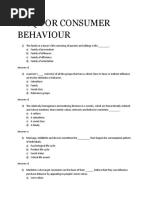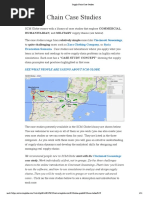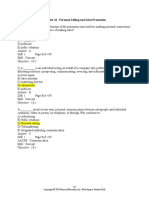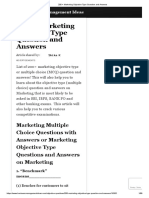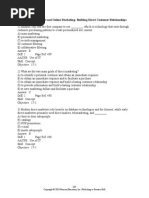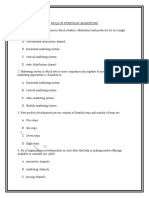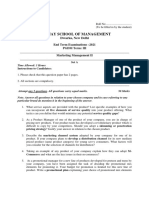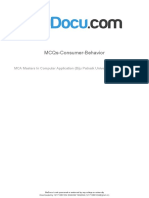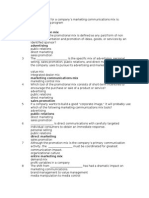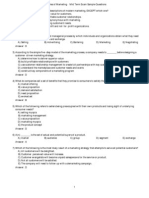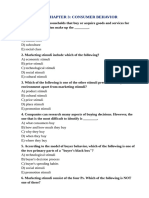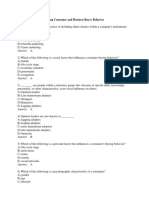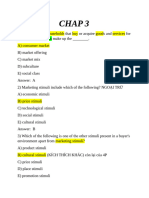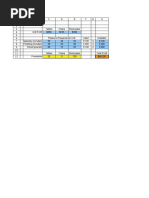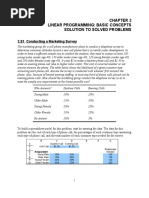Kotler Chapter 6 MCQ
Kotler Chapter 6 MCQ
Uploaded by
Bidyut Bhusan PandaCopyright:
Available Formats
Kotler Chapter 6 MCQ
Kotler Chapter 6 MCQ
Uploaded by
Bidyut Bhusan PandaOriginal Title
Copyright
Available Formats
Share this document
Did you find this document useful?
Is this content inappropriate?
Copyright:
Available Formats
Kotler Chapter 6 MCQ
Kotler Chapter 6 MCQ
Uploaded by
Bidyut Bhusan PandaCopyright:
Available Formats
lOMoARcPSD|5347814
Kotler-Chapter-6-MCQ
Marketing Management (National Cheng Kung University)
StuDocu is not sponsored or endorsed by any college or university
Downloaded by Bidyut Bhusan Panda (bidyutvicky@gmail.com)
lOMoARcPSD|5347814
Chapter 6 Analyzing Consumer Markets
1) ________ is the study of how individuals, groups, and organizations select, buy, use, and dispose of
goods, services, ideas, or experiences to satisfy their needs and wants. D) Consumer behavior
2) Which of the following would be the best illustration of a subculture? A) a religion
3) The relatively homogeneous and enduring divisions in a society, which are hierarchically ordered and
whose members share similar values, interests, and behavior constitute ________. C) a social class
4) A person's ________ consist(s) of all the groups that have a direct (face-to-face) or indirect influence
on his/her attitudes or behavior. D) reference groups
5) A(n) ________ group is one whose values or behavior an individual rejects. B) disassociative
6) Joe is a computer service technician. People in his neighborhood usually depend on his suggestions
for purchasing any computer accessory or hardware, as they believe that he has access to far more
information on computer technology than the average consumer. The neighbors are also aware that Joe
has the required knowledge and background for understanding the technical properties of the products.
Within this context, Joe can be called a(n) ________. B) opinion leader
7) For a high-school student, Tim is highly concerned about environmental issues. He is a strong
supporter of the garbage recycling and afforestation campaigns taken up by the environmental activists
in his neighborhood. He wants to become a full time volunteer for their upcoming wildlife protection
program and has even saved money to contribute to the cause. This group of environmental activists
can be categorized under which of the following reference groups? C) aspirational group
8) Jason writes a weekly column in his school's newspaper about movies he has seen, books he has read,
and concerts he has attended. His column provides information and opinions. Feedback from his fellow
students is positive, and they are appreciative of the advice that is given. Which of the following would
be the most apt description of the role played by Jason? E) opinion leader
9) Social classes differ in media preferences, with upper-class consumers often preferring ________ and
lower-class consumers often preferring television. D) magazines and books
10) If a direct-mail marketer wished to direct promotional efforts toward the family of ________, efforts
need to be directed toward parents and siblings of the family members. A) orientation
11) The family in a buyers life consisting of parents and siblings is the ________. D) family of orientation
12) When Gary was a high school student, he enjoyed rock music and regularly purchased hip clothing
sported by his favorite rock band. However, five years later, when Gary became an accountant, his
preference shifted toward formal clothing. Which of the following personal characteristics is likely to
have had the most influence on Gary's preferences during his high school days? B) age
13) Marriage, childbirth, and divorce constitute the ________ that shape the consumption pattern of
individuals. E) critical life events
14) Identify an economic circumstance that can greatly affect any product or brand choice. D) borrowing
power
Downloaded by Bidyut Bhusan Panda (bidyutvicky@gmail.com)
lOMoARcPSD|5347814
15) ________ refers to a set of distinguishing human psychological traits that lead to relatively
consistent and enduring responses to environmental stimuli. B) Personality
16) Brand personality analysts identified the popular music channel MTV as daring, spirited, and highly
imaginative. As per Jennifer Aaker's research, which of the following brand personality traits best suits
MTV? A) excitement
17) The Marlboro Man was depicted in the advertisements of Marlboro cigarettes as a rugged outdoor,
tough cowboy type. This was done to establish what is called ________. C) a brand personality
18) Consumers often choose and use brands that have a brand personality consistent with how they see
themselves, also known as the ________. A) actual self-concept
19) Consumers often choose and use brands that have a brand personality consistent with how they
think others view them, also known as the ________. B) others' self-concept
20) Consumers who are highly sensitive to how others see them and who choose brands whose
personalities fit the consumption situation are called ________. C) self monitors
21) Within the context of Jennifer Aaker's analysis, identify the brand personality that can be associated
with a new product whose promotional messages consistently portray it as being reliable, intelligent,
and successful. C) competence
22) Ford motors, uses the ad caption "Magnify the Adventure" to promote its latest SUV, the Ford
Endeavour. The ad features the car traveling through an uneven, rocky terrain. Within the context of
Jennifer Aaker's brand personality analysis, Ford Endeavour is most likely to be strong on which of the
following traits? E) ruggedness
23) ________ portrays the "whole person" interacting with his or her environment. C) Lifestyle
24) Consumers who worry about the environment and want products to be produced in a sustainable
way have been named ________. C) "LOHAS"
25) IKEA has achieved global recognition by offering consumers leading-edge Scandinavian furniture at
affordable prices. IKEA is delivering value to consumers who are ________. A) money constrained
26) Marketers who target consumers on the basis of their ________ believe that they can influence
purchase behavior by appealing to people's inner selves. E) core values
27) The starting point for understanding consumer behavior is the ________ model in which marketing
and environmental stimuli enter the consumer's consciousness, and a set of psychological processes
combine with certain consumer characteristics to result in decision processes and purchase decisions. D)
stimulus-response
E) projective
28) ________ assumed that the psychological forces shaping people's behavior are largely unconscious,
and that a person cannot fully understand his or her own motivations. C) Sigmund Freud
29) Which of the following techniques was suggested by Freud to trace a person's motivations from the
stated instrumental ones to the more terminal ones? A) laddering
Downloaded by Bidyut Bhusan Panda (bidyutvicky@gmail.com)
lOMoARcPSD|5347814
30) Which of the following theories developed by Frederick Herzberg distinguishes dissatisfiers from
satisfiers? E) two-factor theory
31) At the top of Maslow's hierarchy of needs (shown as a pyramid in the text) are ________ needs. B)
self-actualization
32) ________ is the process by which we select, organize, and interpret information inputs to create a
meaningful picture of the world. B) Perception
33) ________ can work to the advantage of marketers with strong brands when consumers make
neutral or ambiguous brand information more positive. B) Selective distortion
34) ________ is the tendency to interpret information in a way that will fit our preconceptions. C)
Selective distortion
35) Marketers embed covert messages in ads or packaging of which the consumers are not consciously
aware, yet it affects their behavior. This technique employed by the marketers targets the ________ of a
consumer. C) subliminal perception
36) ________ teaches marketers that they can build demand for a product by associating it with strong
drives, using motivating cues, and providing positive reinforcement. B) Learning theory
37) Anne is a frequent purchaser of Yoplait strawberry yogurt. For once, she decides to try a different
flavored yogurt. Instead of trying out the flavors offered by competing brands, Anne selects a different
flavor offered by Yoplait. Here, her past experience with the brand prompts her to make the choice.
Anne's behavior can be best described as ________. C) generalization
38) The ________ says people have a general tendency to attribute success to themselves and failure to
external causes. E) hedonic bias
39) As Rita scans the yellow pages section of her phone book looking for a florist, she sees several other
products and services advertised. Though interesting on first glance, she quickly returns to her primary
task of finding a florist. The items that distracted her from her initial search were most likely stored in
which of the following types of memory? A) Short-term memory
40) Betsy, a teenager, uses most of her post school hours in either playing tennis or watching movies.
She barely manages to concentrate in her lessons for a couple of hours before term exams. Being
questioned about her substandard performance in the school, she points out the teacher's inability to
complete the entire course during the school hours as the possible reason. Betsy's behavior is most
likely to be associated with ________. B) hedonic bias
41) The associative network memory model views long-term memory as ________. E) a set of nodes and
links
42) ________ refers to the process in which information gets out of memory. A) Memory encoding
43) Amtex electronics, a consumer products brand, advertises its products inside supermarkets and
retail stores frequently to promote the process of ________ and stimulate purchase. B) memory
retrieval
Downloaded by Bidyut Bhusan Panda (bidyutvicky@gmail.com)
lOMoARcPSD|5347814
44) Cognitive psychologists believe that memory is ________, so that once information becomes stored
in memory, its strength of association decays very slowly. E) extremely durable
45) The milder information search state where a person simply becomes more receptive to information
about a product is called ________. C) heightened attention
46) The buying process starts when the buyer recognizes a(n) ________. D) problem or need
47) Which of the following is considered to be a more advanced form of information search wherein the
person might phone friends or go online to secure information about a product or service? E) active
information search
48) Of key interest to marketers are the major informational sources to which the consumer will turn
and the relative importance of each. Which of the following can be considered an experiential
information source? E) personal handing and examination
49) Brands that meet consumers' initial buying criteria are called the ________. C) consideration set
50) Maria considers buying a car for herself, after she notices the advantages derived by her best friend
from his new car. Which of the following forms of stimulus has activated Maria's problem recognition
process? A) external stimuli
51) A consumer who uses Google to find comparative reports on new automobiles, is most likely using
which of the following information sources for assistance? D) commercial
52) With respect to consumer decision making, the ________ is the set of strong contenders from which
one will be chosen as a supplier of a good or service. D) choice set
53) A(n) ________ is a descriptive thought that a person holds about something. B) belief
54) A(n) ________ puts people into a frame of mind, such as, liking or disliking an object, moving toward
or away from it. A) attitude
55) Marketers need to identify the hierarchy of attributes that guide consumer decision making in order
to understand different competitive forces and how these various sets get formed. This process of
identifying the hierarchy is called ________. A) market partitioning
56) ________ are a person's enduring favorable or unfavorable evaluations, emotional feelings, and
action tendencies toward some object or idea. E) Attitudes
57) The expectancy-value model of attitude formation posits that consumers evaluate products and
services by combining their ________. D) brand beliefs
58) Gordon Jones is considering purchasing a computer from Best Buy. He has created a scale for rating
eight different computers on three different characteristics. He plans to short-list only those computers,
that score at least a seven on his scale on all three characteristics. Which of the following choice
heuristics has he chosen? C) conjunctive heuristic
59) With the ________ heuristic, the consumer sets a minimum acceptable cutoff level for each
attribute and chooses the first alternative that meets the minimum standard for all attributes. A)
conjunctive
Downloaded by Bidyut Bhusan Panda (bidyutvicky@gmail.com)
lOMoARcPSD|5347814
60) ________ are rules of thumb or mental shortcuts in the decision process. C) Heuristics
61) Even if consumers form brand evaluations, two general factors can intervene between the purchase
intention and the purchase decision. One of these is unanticipated situational factors. What is the other
factor? B) Attitudes of others
62) A mobile phone manufacturing company observes that the main reason for an abrupt fall in their
sales volume is the unconventional design of their phones that consumers found inconvenient and
unattractive. The findings prompt the company to adopt a new strategy. They redesigned the product
models keeping the requirements of the end-user in mind. According to the expectancy value-model,
the company's strategy can be termed as ________. B) real repositioning
63) Ford believes its cars to be of higher quality than General Motor's but thinks that consumers wrongly
believe the opposite. Ford might employ a(n) ________ strategy to change buyers' perceptions of its
competition. B) competitive depositioning
64) When a marketer tries to alter a consumer's beliefs about a company's brand to get the consumer to
rethink a purchase decision, the marketer is using ________. A) psychological repositioning
65) With the ________, the consumer chooses the best brand on the basis of its perceived most
important attribute.A) lexicographic heuristic
66) ________ risk occurs if the product fails to perform up to expectations. E) Functional
67) Steve has only 20 minutes to have lunch. Although he really likes McDonald's, the line is very long
and he is concerned that he will not have a chance to get through the line and eat his lunch before he is
due back at work. Steve perceives ________ in going to McDonald's today. A) time risk
68) A key driver of sales frequency is the product ________ rate. A) consumption
69) The level of engagement and active processing undertaken by the consumer in responding to a
marketing stimulus is called ________. C) consumer involvement
70) A consumer is persuaded to buy a product by a message that requires little thought and is based on
an association with a brand's positive consumption experiences from the past. In this situation, the
consumer used a ________ to arrive at this purchase decision. B) peripheral route
71) Richard Petty and John Cacioppo's ________, an influential model of attitude formation and change,
describes how consumers make evaluations in both low- and high-involvement circumstances. B)
elaboration likelihood model
72) Which of the following products is most likely to be characterized by low involvement but significant
brand difference? A) toothpastes
73) With the ________, predictions of usage are based on quickness and ease of use. A) availability
heuristic
74) A consumer tells another consumer, "Every time I eat at Big Bill's Steakhouse, I get poor service."
Whether this is true or not, it is the consumer's perception. This is an example of consumers basing
future predictions on the quickness and ease with which a particular example of an outcome comes to
mind. This scenario would be an illustration of the ________ heuristic. C) availability
Downloaded by Bidyut Bhusan Panda (bidyutvicky@gmail.com)
lOMoARcPSD|5347814
75) Ben always reaches for the bright blue and yellow box of Ritz crackers when he visits the snack food
aisle in the grocery store. He rarely even reads the box or checks the price. Which of the following
heuristics is most likely being used by Ben? B) Representative
76) ________ refers to the manner in which consumers code, categorize, and evaluate financial
outcomes of choices. D) Mental accounting
Downloaded by Bidyut Bhusan Panda (bidyutvicky@gmail.com)
lOMoARcPSD|5347814
77) Social class is the fundamental determinant of a person's wants and behavior.
FALSE
Page Ref: 151
Objective: 1
Difficulty: Easy
78) An example of a subculture would be a person's geographic region.
TRUE
Page Ref: 153
Objective: 1
Difficulty: Easy
79) Groups that have an indirect influence on a person's attitude or behavior can be a part of his/her
reference groups.
TRUE
Page Ref: 153
Objective: 1
Difficulty: Moderate
80) Members within a social class tend to behave more alike compared to members from two different
social classes.
TRUE
Page Ref: 153
Objective: 1
Difficulty: Easy
81) Secondary groups require continuous interaction to be effective and meaningful.
FALSE
Page Ref: 153
Downloaded by Bidyut Bhusan Panda (bidyutvicky@gmail.com)
lOMoARcPSD|5347814
Objective: 1
Difficulty: Moderate
82) When Mark went to college he had a burning desire to join a social fraternity; for Mark, the
fraternity would be a dissociative group.
FALSE
Page Ref: 153
Objective: 1
AACSB: Analytic skills
Difficulty: Moderate
83) A person's position in a group is defined in terms of role and status.
TRUE
Page Ref: 154
Objective: 1
Difficulty: Moderate
84) Marketers need to be aware of the status-symbol potential of brands because people usually choose
products which reflect their role and their actual or desired status in a society.
TRUE
Page Ref: 155
Objective: 1
Difficulty: Easy
85) The behavior people exhibit as they pass through certain life-cycle stages, such as becoming a
parent, is largely fixed and does not change over time.
FALSE
Page Ref: 155
Objective: 1
Difficulty: Moderate
Downloaded by Bidyut Bhusan Panda (bidyutvicky@gmail.com)
lOMoARcPSD|5347814
86) For an employee at an organization, annual appraisal can be considered as a critical life event that
impacts his/her consumption behavior.
FALSE
Page Ref: 156
Objective: 1
AACSB: Analytic skills
Difficulty: Easy
87) Whereas economic circumstances can have a profound effect on consumption, occupation does not
impact how people spend their money and what they buy.
FALSE
Page Ref: 156
Objective: 1
Difficulty: Easy
88) According to the research conducted by Jennifer Aaker, one of the five traits of a product's brand
personality is its physical structure.
FALSE
Page Ref: 157
Objective: 1
AACSB: Analytic skills
Difficulty: Moderate
89) Brand personality is the specific mix of human traits that may be attributed to a particular brand.
TRUE
Page Ref: 157
Objective: 1
Difficulty: Easy
Downloaded by Bidyut Bhusan Panda (bidyutvicky@gmail.com)
lOMoARcPSD|5347814
90) The five brand personality traits identified by Jennifer Aaker are consistently observed regardless of
nationality or culture.
FALSE
Page Ref: 157
Objective: 1
AACSB: Multicultural diversity
Difficulty: Moderate
91) A person's personality portrays the "whole person" interacting with his or her environment.
FALSE
Page Ref: 157
Objective: 1
Difficulty: Easy
92) Consumers who experience money constraints are prone to multitasking.
FALSE
Page Ref: 158
Objective: 1
Difficulty: Moderate
93) Psychogenic needs arise from the physiological states of tension such as hunger or discomfort.
FALSE
Page Ref: 160
Objective: 2
Difficulty: Moderate
94) Sigmund Freud assumed that the psychological forces shaping people's behavior are largely
unconscious, and that people cannot fully understand their motivations.
TRUE
Downloaded by Bidyut Bhusan Panda (bidyutvicky@gmail.com)
lOMoARcPSD|5347814
Page Ref: 160
Objective: 2
Difficulty: Easy
95) According to Maslow's hierarchy of needs model, recognition, self-esteem, and status would
constitute a person's social needs.
FALSE
Page Ref: 161
Objective: 2
Difficulty: Moderate
96) According to Herzberg's two-factor theory, satisfiers will make the major difference as to which
brand the customer buys.
TRUE
Page Ref: 161
Objective: 2
Difficulty: Moderate
97) Perception depends only on the physical stimuli experienced by the person.
FALSE
Page Ref: 162
Objective: 2
Difficulty: Moderate
98) People are more likely to notice stimuli whose deviations are large in relation to the normal size of
the stimuli.
TRUE
Page Ref: 162
Objective: 2
Difficulty: Moderate
Downloaded by Bidyut Bhusan Panda (bidyutvicky@gmail.com)
lOMoARcPSD|5347814
99) Selective attention is the tendency to interpret information in a way that will fit our preconceptions.
FALSE
Page Ref: 162
Objective: 2
Difficulty: Moderate
100) Selective retention works to the advantage of strong brands.
TRUE
Page Ref: 162
Objective: 2
Difficulty: Easy
101) Because of selective retention, we are likely to forget about the good points of competing
products.
TRUE
Page Ref: 162
Objective: 2
Difficulty: Moderate
102) Consistent with the elaboration memory model, consumer brand knowledge in memory can be
conceptualized as consisting of a brand node in memory with a variety of linked associations.
FALSE
Page Ref: 163
Objective: 2
Difficulty: Moderate
103) Brand associations consist of all brand-related thoughts, feelings, perceptions, images, experiences,
beliefs, attitudes, and so on that become linked to the brand node.
TRUE
Downloaded by Bidyut Bhusan Panda (bidyutvicky@gmail.com)
lOMoARcPSD|5347814
Page Ref: 164
Objective: 2
Difficulty: Easy
104) Memory is a very constructive process. This means people do not remember information and
events completely and accurately and often remember only bits and pieces that they fill in based on
whatever else they know.
TRUE
Page Ref: 165
Objective: 2
Difficulty: Moderate
105) Every consumer has to pass through all five stages of the buying process when in a buying situation.
FALSE
Page Ref: 166
Objective: 3
Difficulty: Moderate
106) The buying process starts when the buyer decides to or actually enters a store or service provider's
facility.
FALSE
Page Ref: 167
Objective: 3
Difficulty: Moderate
107) A belief is a person's enduring favorable or unfavorable evaluation, emotional feeling, and action
tendency toward some object or idea.
FALSE
Page Ref: 168
Objective: 3
Downloaded by Bidyut Bhusan Panda (bidyutvicky@gmail.com)
lOMoARcPSD|5347814
Difficulty: Moderate
108) The expectancy-value model of attitude formation posits that consumers evaluate products and
services by combining their brand beliefs according to importance.
TRUE
Page Ref: 169
Objective: 3
Difficulty: Moderate
109) If a company finds that a consumer has chosen a competitive product over their company's
offering, one way to get the consumer back could be by developing a strategy wherein the company
"shifts the buyer's ideals" on one or more levels.
TRUE
Page Ref: 170
Objective: 3
AACSB: Analytic skills
Difficulty: Difficult
110) With noncompensatory models of consumer choice, positive and negative attribute considerations
usually net out.
FALSE
Page Ref: 170
Objective: 3
Difficulty: Moderate
111) Volvo has the reputation for being one of the most "safe" cars on the road. For those that value
safety, Volvo would be the logical choice. This is an example of the lexicographic heuristic of consumer
choice.
TRUE
Page Ref: 170
Objective: 3
Downloaded by Bidyut Bhusan Panda (bidyutvicky@gmail.com)
lOMoARcPSD|5347814
AACSB: Analytic skills
Difficulty: Moderate
112) When consumers evaluate the risks associated with a purchase, only real risks with a high
likelihood of occurrence should be considered.
FALSE
Page Ref: 171
Objective: 3
Difficulty: Moderate
113) Psychological risk refers to the threat posed by a product to the physical well-being of a consumer.
FALSE
Page Ref: 171
Objective: 3
Difficulty: Moderate
114) With respect to a consumer buying situation that involves variety-seeking behavior, the market
leader generally encourages variety seeking by offering lower prices or deals.
FALSE
Page Ref: 174
Objective: 3
Difficulty: Moderate
115) Anchoring heuristic comes in to play when consumers base their predictions on the quickness and
ease with which a particular example of an outcome comes to mind.
FALSE
Page Ref: 176
Objective: 4
AACSB: Analytic skills
Difficulty: Moderate
Downloaded by Bidyut Bhusan Panda (bidyutvicky@gmail.com)
lOMoARcPSD|5347814
116) The prospect theory maintains that consumers frame decision alternatives in terms of gains and
losses according to a value function.
TRUE
Page Ref: 177
Objective: 4
Difficulty: Moderate
Downloaded by Bidyut Bhusan Panda (bidyutvicky@gmail.com)
lOMoARcPSD|5347814
117) Explain the differences between culture, subculture, and social class.
Culture is the fundamental determinant of a person's wants and behavior. Subcultures provide more
specific identification and socialization of their members. Subcultures include nationalities, religions,
racial groups, and geographic regions. Social class is a relatively homogeneous and enduring division in a
society, that are hierarchically ordered and whose members share similar values, interests, and
behaviors.
118) What is a reference group? Describe three different types of reference groups that can have an
impact on a consumer's purchasing behavior.
Reference groups consist of all the groups that have a direct (face-to-face) or indirect influence on
attitudes or behavior. Types of reference groups that can impact a consumer's purchasing behavior
include membership groups, primary groups, secondary groups, aspirational groups, and disassociative
groups.
Membership groups are the groups which have a direct influence on the person. Primary groups are the
groups with whom the person interacts fairly continuously and informally, such as family, friends,
neighbors, and coworkers. Secondary groups tend to be more formal and require less continuous
interaction. Aspirational groups are those a person hopes to join; and dissociative groups are those
whose values or behavior an individual rejects.
119) The family is the most important consumer buying organization in society, and family members
constitute the most influential primary reference group. We can distinguish between two family
categorization in the buyer's life. Name the two families and their impact on buying behavior.
The family of orientation consists of parents and siblings. From parents a person acquires an orientation
toward religion, politics, and economics and a sense of personal ambition, self-worth, and love. Even if
the buyer no longer interacts very much with his or her parents, their influence on behavior can be
significant. A more direct influence on everyday buying behavior is the family of procreation—namely,
one's spouse and children.
120) Each person has personality characteristics that influence his or her buying behavior. What does
personality mean in terms of buying traits?
Personality is often described in terms of such buying traits as self-confidence, dominance, autonomy,
deference, sociability, defensiveness, and adaptability. Personality can be a useful variable in analyzing
consumer brand choices. The idea is that brands also have personalities, and consumers are likely to
choose brands whose personalities match their own.
121) People from the same subculture, social class, and occupation may lead quite different lifestyles. A
lifestyle is a person's pattern of living in the world as expressed in activities, interests, and opinions.
Lifestyle portrays the "whole person" interacting with his or her environment. Given this information,
describe the LOHAS (an acronym) lifestyle described in the text and its usefulness in marketing.
Consumers who worry about the environment, want products to be produced in a sustainable way, and
spend money to advance their personal development and potential have been named "LOHAS." The
name is an acronym standing for lifestyles of health and sustainability. The market for LOHAS products
Downloaded by Bidyut Bhusan Panda (bidyutvicky@gmail.com)
lOMoARcPSD|5347814
encompasses things such as organic foods, energy-efficient appliances, and solar panels as well as
alternative medicine, yoga tapes, and ecotourism.
122) Frederick Herzberg developed a two-factor theory that distinguishes dissatisfiers and satisfiers.
How does Herzberg's theory affect sellers' marketing strategy?
Herzberg's theory has two implications. First, sellers should do their best to avoid dissatisfiers (for
example, a poor training manual or a poor service policy). Although these things will not sell a product,
they might easily unsell it. Second, the seller should identify the major satisfiers or motivators of
purchase in the market and then supply them. These satisfiers will make the major difference as to
which brand the customer buys.
123) People can emerge with different perceptions of the same object because of three perceptual
processes. List and briefly characterize these processes.
The three processes are selective attention, selective distortion, and selective retention. Selective
attention occurs because a person cannot possibly attend to all the stimuli that he or she is exposed to
during an average day. Some will be screened out. Selective distortion is the tendency to interpret
information in a way that will fit our perceptions. Selective retention occurs because people will fail to
register much information to which they are exposed in memory, but will tend to retain information that
supports their attitudes and beliefs.
124) Explain the concept of selective retention and its association with marketing.
Selective retention says that consumers are likely to remember good points about a product we like and
forget good points about competing products. Selective retention works to the advantage of strong
brands. It also means that marketers need to use repetition in sending messages to their target markets
to make sure their message is not overlooked.
125) Identify three types of risk consumers might perceive in the context of purchasing a car.
Consumers might perceive physical risk (an unsafe car poses a safety risk to the physical well-being of
the driver and passengers), a financial risk (the car might be overpriced or may decline in value so
rapidly that it will have minimal resale value when the consumer tries to resell it), and a functional risk
(the car may not perform to the expectations of the consumer). Students may identify other risks,
including social, psychological, and time risks.
126) What is mental accounting? What, according to Thaler, are the core principles on which mental
accounting is based? Explain with examples.
Mental accounting refers to the way consumers code, categorize, and evaluate financial outcomes of
choices. Formally, it is "the tendency to categorize funds or items of value even though there is no
logical basis for the categorization, e.g., individuals often segregate their savings into separate accounts
to meet different goals even though funds from any of the accounts can be applied to any of the goals."
According to Chicago's Thaler, mental accounting is based on a set of core principles:
1. Consumers tend to segregate gains. When a seller has a product with more than one positive
dimension, it's desirable to have the consumer evaluate each dimension separately. Listing multiple
Downloaded by Bidyut Bhusan Panda (bidyutvicky@gmail.com)
lOMoARcPSD|5347814
benefits of a large industrial product, for example, can make the sum of the parts seem greater than the
whole.
2. Consumers tend to integrate losses. Marketers have a distinct advantage in selling something if its
cost can be added to another large purchase. House buyers are more inclined to view additional
expenditures favorably given the high price of buying a house.
3. Consumers tend to integrate smaller losses with larger gains. The "cancellation" principle might
explain why withholding taxes from monthly paychecks is less aversive than large, lump-sum tax
payments—the smaller withholdings are more likely to be absorbed by the larger pay amount.
4. Consumers tend to segregate small gains from large losses. The "silver lining" principle might explain
the popularity of rebates on big-ticket purchases such as cars.
127) Culture is the fundamental determinant of a person's wants and behavior. The growing child
acquires a set of values, perceptions, preferences, and behaviors through his or her family and other key
institutions. What values are typical American young children exposed to?
According to the text, a child growing up in the United States is exposed to values such as achievement
and success, activity, efficiency and practicality, progress, material comfort, individualism, freedom,
external comfort, humanitarianism, and youthfulness.
128) An opinion leader is the person in informal, product-related communications who offers advice or
information about a specific product or product category, such as which of several brands is best or how
a particular product may be used. According to the text, how do marketers try to reach opinion leaders?
Marketers try to reach opinion leaders by identifying demographic and psychographic characteristics
associated with opinion leadership, identifying the media read by opinion leaders, and directing
messages at opinion leaders.
129) Explain the differences between a role and status.
A role consists of the activities a person is expected to perform. Each role carries a status. For example, a
senior vice-president has more status than a sales manager.
130) Mention the personal factors that can influence the decision of a buyer.
Personal characteristics that influence a buyer's decision include age and stage in the life cycle,
occupation and economic circumstances, personality and self-concept, and lifestyle and values. Because
many of these have a direct impact on consumer behavior, it is important for marketers to follow them
closely.
131) What is brand personality and what are the five traits that has been linked to it?
Brand personality is the specific mix of human traits that may be attributed to a particular brand. Traits
that have been associated with brand personality are sincerity, excitement, competence, sophistication,
and ruggedness.
132) Briefly explain Freud's theory on human motivation and explain how this might be related to
marketing.
Downloaded by Bidyut Bhusan Panda (bidyutvicky@gmail.com)
lOMoARcPSD|5347814
Sigmund Freud assumed that the psychological forces shaping people's behavior are largely
unconscious, and that a person cannot fully understand his or her own stated capabilities. When a
person examines specific brands, he or she will react not only to their stated capabilities, but also to
other, less conscious cues.
133) Within the context of the Freudian theory, explain how the laddering technique can be used.
Shape, size, weight, material, color, and brand name can all trigger certain associations and emotions. A
technique called laddering can be used to trace a person's motivations from the stated instrumental
ones to the more terminal ones. Then the marketer can decide at what level to develop the message
and appeal.
134) Abraham Maslow sought to explain why people are driven by particular needs at particular times.
Describe Maslow's hierarchy of needs. How does Maslow's theory help marketers?
Maslow's hierarchy of needs in order of importance are, physiological needs, safety needs, social needs,
esteem needs, and self-actualization needs. Maslow's theory helps marketers understand how various
products fit into the plans, goals, and lives of consumers.
135) List and briefly characterize Maslow's Hierarchy of Needs.
Beginning with the most basic needs to the most advanced, the need structure is as follows: (1)
physiological needs—food, water, shelter; (2) safety needs—security, protection; (3) social needs—
sense of belonging, love; (4) esteem needs—self-esteem, recognition, status; and (5) self-actualization
needs—self-development and realization.
136) Perception is the process by which an individual selects, organizes, and interprets information
inputs to create a meaningful picture of the world. For a marketer, what is the key point of perception?
The key point is that perceptions can vary widely among individuals exposed to the same reality. In
marketing, perceptions are more important than the reality, as it is perceptions that will affect
consumers' actual behavior.
137) What does the learning theory teach marketers about demand for products?
The learning theory teaches marketers that they can build demand for a product by associating it with
strong drives, using motivating cues, and providing positive reinforcement.
138) What are the five stages of the consumer buying process?
The five stages are problem recognition, information search, evaluation of alternatives, purchase
decision, and postpurchase behavior.
139) Describe how the problem recognition process works in the five-stage model of the consumer
buying process.
The buying process starts when the buyer recognizes a problem or need. With an internal stimulus, one
of the person's normal needs—hunger, thirst, sex—rises to a threshold level and becomes a drive; or a
need can be aroused by an external stimuli such as an advertisement.
Downloaded by Bidyut Bhusan Panda (bidyutvicky@gmail.com)
lOMoARcPSD|5347814
140) Through market research a consumer gathers information about the competing brands of a
product and their features. The consumer then advances through four sets with respect to brands
before a decision is reached. What are those four sets?
The four sets are: (1) the total set, (2) the awareness set, (3) the consideration set, and (4) the choice
set.
141) Explain the differences between a belief and an attitude.
A belief is a descriptive thought that a person holds about something. An attitude is a person's enduring
favorable or unfavorable evaluation, emotional feeling, and action tendencies toward some object or
idea.
142) What do you understand by the term market partitioning?
Marketers need to identify the hierarchy of attributes that guide consumer decision making in order to
understand different competitive forces and how these various sets get formed. This process of
identifying the hierarchy is called market partitioning.
143) How is the expectancy-value model used in the evaluation of alternatives as a consumer engages in
a buying process?
The expectancy-value model of attitude formation posits that consumers evaluate products and services
by combining their brand beliefs—the positives and negatives—according to importance. The model
assists consumers in making choices.
144) Describe the lexicographic heuristic used to make consumer choices.
The lexicographic heuristic is in use when the consumer chooses the best brand on the basis of its
perceived most important attribute.
145) What four strategies can marketers of low-involvement products employ in an effort to convert
their products into ones of higher involvement?
The four strategies are: (1) linking the product to some involving issue; (2) linking the product to some
involving personal situation; (3) designing advertising to trigger strong emotions related to personal
values or ego defense; and (4) adding important features to the product.
146) Heuristics can come into play when consumers forecast the likelihood of future outcomes or
events. When would a consumer use an anchoring and adjustment heuristic?
Consumers will use this heuristic when the consumer arrives at an initial judgment and then makes
adjustments of that first impression based on additional information.
Downloaded by Bidyut Bhusan Panda (bidyutvicky@gmail.com)
You might also like
- Consumer Behavior MCQDocument6 pagesConsumer Behavior MCQNikita Rekhate100% (5)
- 5100 MTDocument144 pages5100 MTlgoNo ratings yet
- Principles of Marketing Chapter 5 Test Bank PDFDocument45 pagesPrinciples of Marketing Chapter 5 Test Bank PDFmira chehabNo ratings yet
- Designing and Managing Integrated Marketing Communications Chapter 17Document14 pagesDesigning and Managing Integrated Marketing Communications Chapter 17Subhajit KarmakarNo ratings yet
- 1 QuizDocument23 pages1 QuizThu Hiền KhươngNo ratings yet
- Kotler Chapter20Document45 pagesKotler Chapter20كنز knz86% (7)
- Kotler Chapter 12 MCQDocument41 pagesKotler Chapter 12 MCQAnthony Scott88% (66)
- Examples of Examination Questions: Multiple ChoiceDocument12 pagesExamples of Examination Questions: Multiple ChoiceSreekanth NagloorNo ratings yet
- Supply Chain Case Studies 12Document11 pagesSupply Chain Case Studies 12Bidyut Bhusan Panda50% (2)
- Chapter 1 Marketing: Creating Customer Value and EngagementDocument11 pagesChapter 1 Marketing: Creating Customer Value and EngagementTống Hương GiangNo ratings yet
- Sales Management MCQ CHP 01 and 02Document4 pagesSales Management MCQ CHP 01 and 02jayant bansalNo ratings yet
- MKT 421 Final Exam A. DONE PDFDocument8 pagesMKT 421 Final Exam A. DONE PDFshemikastanfield_9300% (4)
- Chapter 12 Test Bank AnswersDocument3 pagesChapter 12 Test Bank AnswersYumna WafaNo ratings yet
- Kotler 13 Tif 01Document18 pagesKotler 13 Tif 01MiNoChanNo ratings yet
- Kotler Chapter 16 MCQDocument42 pagesKotler Chapter 16 MCQAnthony Scott76% (29)
- Chapter 8: Identifying Market Segments and Targets: General Concept Questions Multiple ChoiceDocument29 pagesChapter 8: Identifying Market Segments and Targets: General Concept Questions Multiple ChoiceRazan Abuayyash100% (1)
- 200 + Marketing Objective Type Question and AnswersDocument89 pages200 + Marketing Objective Type Question and Answersmonalisha mishra100% (1)
- Final Test Bank Principles of MarketingDocument4 pagesFinal Test Bank Principles of MarketingWindyNo ratings yet
- Marketing (Chapter 10) - KotlerDocument37 pagesMarketing (Chapter 10) - KotlerMarcus Thong67% (18)
- MM Chapter 4 Test BankDocument9 pagesMM Chapter 4 Test BankkarimNo ratings yet
- MM Chapter 11 Test BankDocument13 pagesMM Chapter 11 Test BankkarimNo ratings yet
- MBA - Marketing - Sample Test 1Document5 pagesMBA - Marketing - Sample Test 1Ash Kumar MishraNo ratings yet
- Integrated Marketing CommunicationDocument22 pagesIntegrated Marketing CommunicationMallikarjun Reddy Avisala100% (1)
- Marketing Question Bank 2015-173rd Semoct 2016Document43 pagesMarketing Question Bank 2015-173rd Semoct 2016akash jainNo ratings yet
- Dokumen - Tips Kotler Chapter 7 MCQDocument42 pagesDokumen - Tips Kotler Chapter 7 MCQIman ChyunaNo ratings yet
- Kotler-Chapter-10-MCQ Kotler-Chapter-10-MCQDocument23 pagesKotler-Chapter-10-MCQ Kotler-Chapter-10-MCQHamza AsifNo ratings yet
- Fdocuments - in Kotler Chapter 8 MCQDocument44 pagesFdocuments - in Kotler Chapter 8 MCQKAIVALYA PAINo ratings yet
- Marketing ManagementDocument8 pagesMarketing ManagementAdnan ArshadNo ratings yet
- Final Exam Marketing ManagementDocument4 pagesFinal Exam Marketing ManagementMichelle GoNo ratings yet
- CH 02 AnswersDocument25 pagesCH 02 AnswerscheekbutterNo ratings yet
- CH 8Document25 pagesCH 8Haider Ali Farrukh100% (1)
- BBA 505B Sales-MAnagementDocument62 pagesBBA 505B Sales-MAnagementNithin RajuNo ratings yet
- Advt MCQ For Form 3Document3 pagesAdvt MCQ For Form 3Aejaz MohamedNo ratings yet
- Chapter 17 Direct and Online Marketing: Building Direct Customer RelationshipsDocument42 pagesChapter 17 Direct and Online Marketing: Building Direct Customer RelationshipsManoj Reddy80% (5)
- Mcqs of Stretagic Marketing 1Document15 pagesMcqs of Stretagic Marketing 1FaiEz AmEen KhanNo ratings yet
- Final Exam Study Guide - MarketingDocument4 pagesFinal Exam Study Guide - MarketingNicole McCoy Wilson50% (2)
- Chapter 1 Marketing: Creating and Capturing Customer ValueDocument21 pagesChapter 1 Marketing: Creating and Capturing Customer ValueAbdullah JuttNo ratings yet
- Chap 14 - Marketing Test BankDocument26 pagesChap 14 - Marketing Test Bankarmaghan.ansariNo ratings yet
- Marketing Management 2 Question PaperDocument3 pagesMarketing Management 2 Question PaperPranshuNo ratings yet
- Mcqs-Consumer-Behavior Mcqs-Consumer-BehaviorDocument25 pagesMcqs-Consumer-Behavior Mcqs-Consumer-Behaviorsamaya pypNo ratings yet
- Kotler Mm13e Tif 06Document27 pagesKotler Mm13e Tif 06Kad Saad100% (1)
- Final MCQ For Conumer BehaviorDocument25 pagesFinal MCQ For Conumer BehaviorSrivatsav Sri100% (1)
- Consumer Behaviour Solved MCQs (Set-1)Document6 pagesConsumer Behaviour Solved MCQs (Set-1)guddan prajapatiNo ratings yet
- The Promotion MixDocument5 pagesThe Promotion Mixkeshavrathi183% (6)
- Social Marketing QuestionsDocument32 pagesSocial Marketing QuestionsyulianandualemNo ratings yet
- Kotler Chapter 17 MCQ - Direct Marketing - Online AdvertisingDocument11 pagesKotler Chapter 17 MCQ - Direct Marketing - Online AdvertisingyyyNo ratings yet
- Fdocuments - in - Kotler Chapter 9 MCQDocument40 pagesFdocuments - in - Kotler Chapter 9 MCQKAIVALYA PAINo ratings yet
- MM Chapter 12 Test BankDocument10 pagesMM Chapter 12 Test BankkarimNo ratings yet
- MidtermDocument39 pagesMidtermJerry Lam75% (12)
- Principles of Marketing - MGT301 Solved Mcqs PDFDocument51 pagesPrinciples of Marketing - MGT301 Solved Mcqs PDFsehar Shah nawaz100% (1)
- Chapter 11Document40 pagesChapter 11Minh Thu TranNo ratings yet
- MCQ Bank Ch1 Pom KotlerDocument5 pagesMCQ Bank Ch1 Pom Kotlerhasib_ahsan100% (1)
- Marketing MCQ Part-2Document2 pagesMarketing MCQ Part-2KyuubiKitty100% (1)
- Marketing Management QuizDocument37 pagesMarketing Management QuizShah HossainNo ratings yet
- CHƯƠNG 3 MKT TNDocument14 pagesCHƯƠNG 3 MKT TNtuongvi27906No ratings yet
- Consumer Buying Behaviour 3Document14 pagesConsumer Buying Behaviour 3Ryan BekinfieldNo ratings yet
- Marketing for Hospitality and Tourism 6th Edition Kotler Test Bank 2024 scribd download full chaptersDocument38 pagesMarketing for Hospitality and Tourism 6th Edition Kotler Test Bank 2024 scribd download full chaptersdesanesyidi100% (6)
- CH 01Document43 pagesCH 01hamedNo ratings yet
- Chapter 5Document6 pagesChapter 5helen457405No ratings yet
- Multiple ChoiceDocument60 pagesMultiple ChoiceThu Hiền Khương0% (1)
- Chap 3Document20 pagesChap 3maiquynh0012No ratings yet
- Why Is Supply Chain Analytics Important?Document13 pagesWhy Is Supply Chain Analytics Important?Bidyut Bhusan PandaNo ratings yet
- The Five Marketing ConceptsDocument4 pagesThe Five Marketing ConceptsBidyut Bhusan PandaNo ratings yet
- What Does Operational Analytics Mean?Document1 pageWhat Does Operational Analytics Mean?Bidyut Bhusan PandaNo ratings yet
- Help in Finance AnalyticsDocument3 pagesHelp in Finance AnalyticsBidyut Bhusan PandaNo ratings yet
- Supply Chain Analysis 101Document3 pagesSupply Chain Analysis 101Bidyut Bhusan PandaNo ratings yet
- The Executive's Guide Supply Chain ManagementDocument13 pagesThe Executive's Guide Supply Chain ManagementBidyut Bhusan PandaNo ratings yet
- What Is Marketing ManagementDocument28 pagesWhat Is Marketing ManagementBidyut Bhusan PandaNo ratings yet
- Penske Logistics Helps Beverage Distributor Rapidly Establish New Warehousing OperationsDocument2 pagesPenske Logistics Helps Beverage Distributor Rapidly Establish New Warehousing OperationsBidyut Bhusan PandaNo ratings yet
- Key Performance Indicators in Supply Chain & LogisticsDocument11 pagesKey Performance Indicators in Supply Chain & LogisticsBidyut Bhusan PandaNo ratings yet
- 7 Mini Case Studies - Successful Supply Chain Cost Reduction and ManagementDocument16 pages7 Mini Case Studies - Successful Supply Chain Cost Reduction and ManagementBidyut Bhusan PandaNo ratings yet
- Network Optimization Problems Solution To Solved Problems: 6.S1 Distribution at Heart BeatsDocument4 pagesNetwork Optimization Problems Solution To Solved Problems: 6.S1 Distribution at Heart BeatsBidyut Bhusan PandaNo ratings yet
- Chap 007Document13 pagesChap 007Bidyut Bhusan PandaNo ratings yet
- Distribution at Heart Beats: From To Flow Capacityunit Cost Nodes Net Flow Supply/Demand Range Name CellsDocument1 pageDistribution at Heart Beats: From To Flow Capacityunit Cost Nodes Net Flow Supply/Demand Range Name CellsBidyut Bhusan PandaNo ratings yet
- Stickley Furniture: A B C D E F G H 1 2 3 4 5 6 7 8 9 10 11 12Document3 pagesStickley Furniture: A B C D E F G H 1 2 3 4 5 6 7 8 9 10 11 12Bidyut Bhusan PandaNo ratings yet
- Chap 002Document4 pagesChap 002Bidyut Bhusan PandaNo ratings yet
- Chap 012Document1 pageChap 012Bidyut Bhusan PandaNo ratings yet
